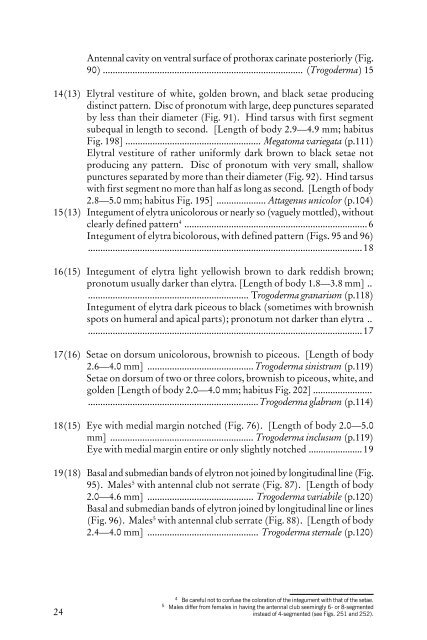Beetles Identification Guide
Beetles Identification Guide
Beetles Identification Guide
Create successful ePaper yourself
Turn your PDF publications into a flip-book with our unique Google optimized e-Paper software.
24<br />
Antennal cavity on ventral surface of prothorax carinate posteriorly (Fig.<br />
90) ................................................................................. (Trogoderma) 15<br />
14(13) Elytral vestiture of white, golden brown, and black setae producing<br />
distinct pattern. Disc of pronotum with large, deep punctures separated<br />
by less than their diameter (Fig. 91). Hind tarsus with first segment<br />
subequal in length to second. [Length of body 2.9—4.9 mm; habitus<br />
Fig. 198] ....................................................... Megatoma variegata (p.111)<br />
Elytral vestiture of rather uniformly dark brown to black setae not<br />
producing any pattern. Disc of pronotum with very small, shallow<br />
punctures separated by more than their diameter (Fig. 92). Hind tarsus<br />
with first segment no more than half as long as second. [Length of body<br />
2.8—5.0 mm; habitus Fig. 195] .................... Attagenus unicolor (p.104)<br />
15(13) Integument of elytra unicolorous or nearly so (vaguely mottled), without<br />
clearly defined pattern 4 ..........................................................................6<br />
Integument of elytra bicolorous, with defined pattern (Figs. 95 and 96)<br />
...............................................................................................................18<br />
16(15) Integument of elytra light yellowish brown to dark reddish brown;<br />
pronotum usually darker than elytra. [Length of body 1.8—3.8 mm] ..<br />
................................................................. Trogoderma granarium (p.118)<br />
Integument of elytra dark piceous to black (sometimes with brownish<br />
spots on humeral and apical parts); pronotum not darker than elytra ..<br />
...............................................................................................................17<br />
17(16) Setae on dorsum unicolorous, brownish to piceous. [Length of body<br />
2.6—4.0 mm] ........................................... Trogoderma sinistrum (p.119)<br />
Setae on dorsum of two or three colors, brownish to piceous, white, and<br />
golden [Length of body 2.0—4.0 mm; habitus Fig. 202] ........................<br />
.....................................................................Trogoderma glabrum (p.114)<br />
18(15) Eye with medial margin notched (Fig. 76). [Length of body 2.0—5.0<br />
mm] .......................................................... Trogoderma inclusum (p.119)<br />
Eye with medial margin entire or only slightly notched ......................19<br />
19(18) Basal and submedian bands of elytron not joined by longitudinal line (Fig.<br />
95). Males 5 with antennal club not serrate (Fig. 87). [Length of body<br />
2.0—4.6 mm] ........................................... Trogoderma variabile (p.120)<br />
Basal and submedian bands of elytron joined by longitudinal line or lines<br />
(Fig. 96). Males 5 with antennal club serrate (Fig. 88). [Length of body<br />
2.4—4.0 mm] ............................................. Trogoderma sternale (p.120)<br />
4 Be careful not to confuse the coloration of the integument with that of the setae.<br />
5 Males differ from females in having the antennal club seemingly 6- or 8-segmented<br />
instead of 4-segmented (see Figs. 251 and 252).
















